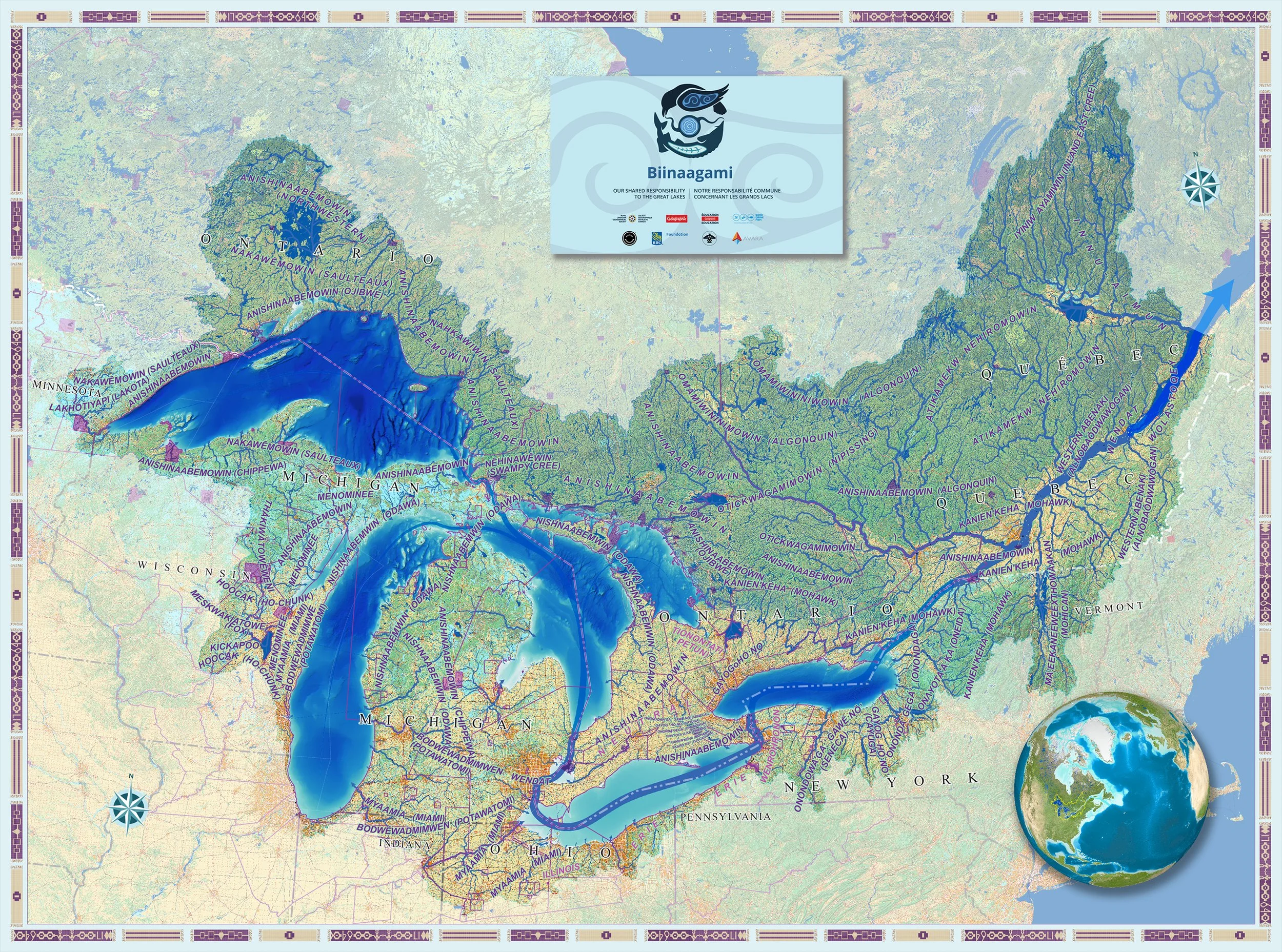Understand, Learn, and Stand Up for the Great Lakes-St. Lawrence River Watershed
Biinaagami Giant Floor Map
Be Part of the Biinaagami Initiative
The Great Lakes-St. Lawrence River watershed is one of the world’s most vital freshwater ecosystems—a living tapestry of people, wildlife, land, water, and history. Yet, for too long, we’ve viewed these waters through the lens of political boundaries and disconnected interests. The Biinaagami initiative is changing that.
Led by Swim Drink Fish, Canadian Geographic, and a Shared Circle of Indigenous leaders, Biinaagami represents a new way of seeing and caring for our watershed.
It’s a movement rooted in Indigenous Knowledges, ceremony, and storytelling, and it calls on all of us—individuals, communities, cities, states, and nations—to accept our shared responsibility for protecting and restoring these waters.
Why Shared Responsibility Matters
Dividing the watershed into isolated “shareholders” is a losing strategy. The enduring health of our waters depends on collaboration, accountability, and a sense of community that transcends borders. Every action—large or small—matters. Whether you live on the lakeshore or hundreds of miles away, your choices impact the future of the basin.
More Than Just Lakes
The watershed is far more than the five (or seven) Great Lakes. It includes thousands of rivers—like the St. Lawrence, Ottawa, St. Clair, Detroit, and Saginaw—and tens of thousands of lakes in regions such as Muskoka, Halliburton, the Kawarthas, the Finger Lakes, and beyond. It’s a place of many languages, cultures, and histories, some stretching back thousands of years. And it’s home to a rich diversity of life—fish, birds, and people—all connected by water.
Reconnecting and Respecting
Despite the global importance of these freshwater ecosystems, many of us have lost our connection to the waters—and with it, our respect. As Lake Ontario Waterkeeper for over two decades, I’ve seen “No Swim, No Fish, No Drink” signs posted along our waterfronts. These warnings protect people, but they do little for wildlife or inspire the action needed to remove them.
The Call to Action
The watershed is calling us to work together. Headlines often focus on sewage, stormwater, chemicals, plastics, development, and nuclear waste. These are urgent issues, but the most powerful solution is shared responsibility. The Biinaagami Initiative is building a broader alliance—one that brings together passionate people, Indigenous leaders, scientists, educators, and community groups from across the region.
Never before has there been an alliance like this—one that unites people who love the Great Lakes-St. Lawrence watershed and want to work together to support it. Biinaagami is the movement our watershed has been yearning for.
How You Can Get Involved
Join the Biinaagami Community: Connect with water leaders, organizations, and initiatives working for a clean water future. Share your story, inspire others, and help transform local action into collective impact.
Explore and Learn: Visit the Biinaagami website to discover interactive maps, stories, and educational resources. Experience the Giant Floor Map, which brings Indigenous Knowledges and watershed science to life for learners of all ages.
Bring the Map to Your Community: Request or find out how to host the Giant Floor Map in your classroom, community center, or local gathering space to share watershed science and Indigenous Knowledges firsthand.
Take Action: Whether you’re a teacher, student, business owner, or concerned community member, there are countless ways to connect, learn, and act. Attend events, participate in restoration projects, and advocate for policies that protect our waters.
Biinaagami means “clean, pure water” in Anishinaabemowin. It’s a call to honour the waters that sustain us, to learn from Indigenous wisdom, and to build a future where everyone shares in the responsibility—and the joy—of caring for our watershed.
Ready to stand up for the Great Lakes-St. Lawrence River watershed?
Visit Biinaagami.org to learn more and join the movement.

